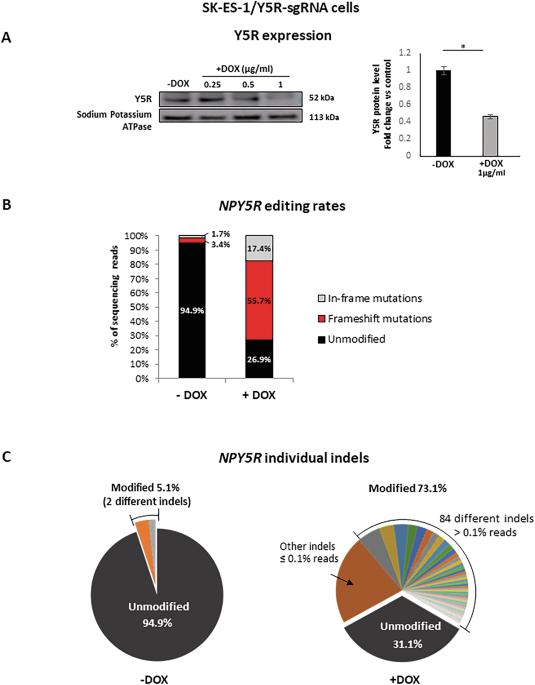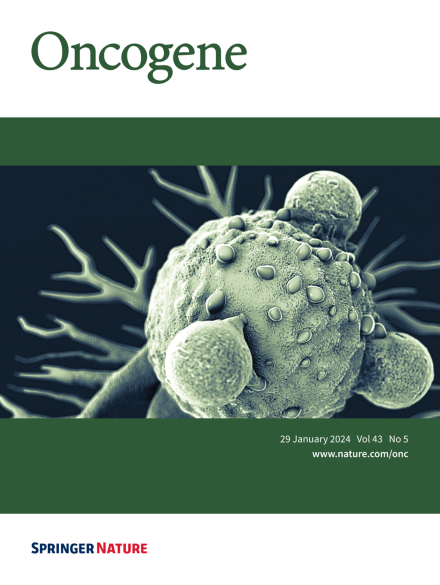靶向CRISPR方法揭示神经肽Y受体Y5在尤文氏肉瘤肺外转移中的重要作用。
IF 7.3
1区 医学
Q1 BIOCHEMISTRY & MOLECULAR BIOLOGY
引用次数: 0
摘要
尤因肉瘤(ES)是一种小儿恶性肿瘤,缺乏足够的治疗转移形式。这些肿瘤组成性地表达神经肽Y (NPY)及其Y5受体(Y5R),导致患者血清中肽水平升高。在动物模型中,分泌NPY的异种移植物转移到肺外壁龛,包括骨;与ES患者不良预后相关的表型。为了确定NPY/Y5R轴在ES肺外传播中的作用,我们使用了一种多西环素诱导的CRISPR/Cas9系统来敲除转移到这些生态位的SK-ES-1异种移植物中的Y5R。我们已经证明,在多西环素治疗的小鼠中,异质SK-ES-1/Y5R-sgRNA原发肿瘤的转移完全由具有功能性NPY5R基因的SK-ES-1克隆引发。同样,野生型SK-ES-1异种移植物的转移与NPY5R基因获得的克隆选择相关。体外实验发现,由RhoA激活驱动的y5r依赖性ES细胞运动是NPY转移效应的机制。在分泌NPY的ES细胞系中,自分泌的NPY/Y5R环负责维持基底细胞的运动,而不释放肽的ES细胞则对外源性NPY做出反应。这些数据为NPY/Y5R轴在ES转移中的关键作用提供了证据。本文章由计算机程序翻译,如有差异,请以英文原文为准。

Targeted CRISPR approach reveals an essential role for neuropeptide Y receptor Y5 in Ewing sarcoma extrapulmonary metastasis
Ewing sarcoma (ES) is a pediatric malignancy that lacks adequate therapies for its metastatic form. These tumors constitutively express neuropeptide Y (NPY) and its Y5 receptor (Y5R), which leads to elevated levels of the peptide in patients’ serum. In animal models, xenografts secreting NPY metastasize to extrapulmonary niches, including bone; the phenotype associated with adverse prognosis in ES patients. To determine the role of the NPY/Y5R axis in ES extrapulmonary dissemination, we used a doxycycline-inducible CRISPR/Cas9 system to knockout Y5R in SK-ES-1 xenografts that metastasize to these niches. We have shown that metastases developing from heterogenous SK-ES-1/Y5R-sgRNA primary tumors in doxycycline-treated mice were initiated exclusively by SK-ES-1 clones with a functional NPY5R gene. Similarly, metastasis from wild type SK-ES-1 xenografts was associated with a selection of clones with NPY5R gene gain. In vitro assays identified Y5R-dependent ES cell motility driven by RhoA activation as the mechanism underlying the metastatic effects of NPY. In ES cell lines that secrete NPY, the autocrine NPY/Y5R loop was responsible for maintaining basal cell motility, while ES cells that do not release the peptide responded to the exogenous NPY. These data provide evidence for the crucial role of the NPY/Y5R axis in ES metastasis.
求助全文
通过发布文献求助,成功后即可免费获取论文全文。
去求助
来源期刊

Oncogene
医学-生化与分子生物学
CiteScore
15.30
自引率
1.20%
发文量
404
审稿时长
1 months
期刊介绍:
Oncogene is dedicated to advancing our understanding of cancer processes through the publication of exceptional research. The journal seeks to disseminate work that challenges conventional theories and contributes to establishing new paradigms in the etio-pathogenesis, diagnosis, treatment, or prevention of cancers. Emphasis is placed on research shedding light on processes driving metastatic spread and providing crucial insights into cancer biology beyond existing knowledge.
Areas covered include the cellular and molecular biology of cancer, resistance to cancer therapies, and the development of improved approaches to enhance survival. Oncogene spans the spectrum of cancer biology, from fundamental and theoretical work to translational, applied, and clinical research, including early and late Phase clinical trials, particularly those with biologic and translational endpoints.
 求助内容:
求助内容: 应助结果提醒方式:
应助结果提醒方式:


